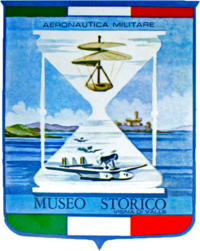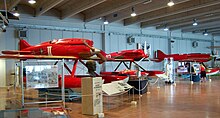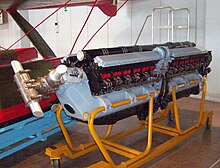Vigna di Valle Italian Aviation Museum
 Museum coat of arms |
|
| Data | |
|---|---|
| place | Strada comunale Vigna di Valle Bracciano |
| Art | |
| opening | May 24, 1977 |
| operator | |
| management |
Lieutenant Colonel Adelio Roviti
|
| Website | |
The Aviation Museum in Vigna di Valle ( Museo storico dell'Aeronautica Militare ) is an aviation museum dedicated to the history of the Italian Air Force and one of the largest of its kind in Italy . It is maintained by Aeronautica Militare and is located in Vigna di Valle, a district of Bracciano on Lake Bracciano in Lazio .
history
The beginnings of the museum go back to 1913, when, on the initiative of then Major Giulio Douhet, an aviation area was set up in the Military Museum in Castel Sant'Angelo in Rome , where objects were exhibited that have been used since the establishment of military aviation in Italy had collected in 1884. In 1933 these exhibits were moved to another museum on the Tiber . It had to stay in makeshift arrangements until 1977. Finally, after a long hesitation, the decision was made to set up a modern museum complex on the historically important former airfield of Vigna di Valle and to concentrate all previous exhibitions there. Until the 1970s, Vigna di Valle on Lake Bracciano was a seaplane base used by the military, on which a SAR squadron last operated on Grumman HU-16 . In the meantime, the museum in Vigna di Valle has already reached its capacity limits despite repeated expansion, which is why it is considered to set up a branch at the Guidonia Montecelio military airfield east of Rome .
exhibition

The museum, which opened on May 24, 1977, has the task of collecting, restoring, preserving and exhibiting valuable military-historical objects from the aviation sector, and in this way making a scientific and didactic contribution to the promotion and maintenance of aviation culture.
The museum is divided into four pavilions. In the Troster area (1,200 m²), exhibits from the pioneering days of aviation up to the First World War can be viewed . There are also some seaplanes from the interwar period. In the Velo pavilion (3,600 m²) there is a collection of double-deckers and airplanes from the inter-war period and some from the Second World War. The 60 × 66 meter Badoni hangar was originally intended for the overhaul of seaplanes and now also serves as an exhibition hall in which aircraft from the Second World War can be seen. Aircraft from the Cold War era are on display in the Skema pavilion (80 × 40 meters).
There is also a documentation center that deals with the life and polar flights of Umberto Nobile . The documentation center also has a library and a collection of photos, paintings, medals, electrical devices, and more.
Visiting the museum is free. It is closed on Mondays, New Years, Easter and Christmas. On all other days it is open from 9.30 a.m. to 4.30 p.m. (from June to September until 5.30 p.m.). Vigna di Valle is located about 40 km northwest of Rome , on the southern shore of Lake Bracciano .
Large parts of the museum were modernized between May and October 2014 and were therefore temporarily closed.
Exhibits (selection)
Propeller planes

- Ansaldo AC.2
- Ansaldo SVA 5
- Caproni about 3
- Caproni approx 100
- Douglas DC-3
- Fiat C.29
- Fiat CR.32
- Fiat CR.42 Falco
- Fiat G.55
- Fiat G.212
- Fieseler Fi 156
- Grumman HU-16A Albatross
- Grumman S2F-1 tracker
- IMAM Ro.37 to
- IMAM Ro.43
- Lohner L
- Macchi M.39
- Macchi M.67
- Macchi-Castoldi MC72
- Macchi MC.200
- Macchi MC.202
- Macchi MC.205
- North American P-51D
- North American T-6J
- SAI Ambrosini p.7
- Savoia-Marchetti SM 79
- Savoia-Marchetti SM 82
- Spitfire LF. IXc MK805
- Stinson L5 Sentinel
- Wright N ° 4
Gliders
- Librator Allievo Cantù
Jet planes
- Aerfer Ariete
- Aerfer Sagittario II
- Campini-Caproni CC2
- Fiat G.91 PAN ( Frecce Tricolori )
- Fiat G.91 R.
- Fiat G.91 T
- Lockheed (Fiat) F-104G Starfighter
- Lockheed RT-33
- Panavia Tornado ADV
- Republic F-84F Thunderstreak
- Republic F-84G Thunderjet
- Republic RF-84F Thunderflash (under restoration)
Engines
Piston engines
- Alfa Romeo 126 RC.34
- Allison V-1710
- As10C
- Daimler-Benz DB 605
- Fiat A20
- Fiat A22T
- Fiat A54
- Fiat AS.6
- Hispano-Suiza 8
- Isotta Fraschini 12 DB
- Isotta Fraschini Asso 750 RC 35
- Maybach airship engine
- Rolls-Royce Merlin
- SPA 6A
- SPA Faccioli
- Wright "Type 4"
Jet engines
Bracciano-Vigna di Valle seaplane base
The Rome-Centocelle military airfield , which opened in 1909, is generally regarded as the oldest airfield in Italy and the cradle of Italian aviation, also because it was an airfield for conventional "land planes", while Lake Bracciano was only used as a seaplane base. If you ignore this difference, Vigna di Valle is the oldest airfield in Italy, at least the oldest sea airfield. In formal terms, today's museum is still part of the Vigna di Valle seaplane base, which is named after the test pilot “Luigi Bourlot” who died in 1918 .
At the instigation of the then major Maurizio Moris , a flight test center was set up in Vigna di Valle in 1904. In 1907 and 1908, under the direction of Gaetano Arturo Crocco and Ottavio Ricaldoni, the first Italian rigid airship "Crocco-Ricaldoni N. 1" was built, which made its maiden flight on October 3, 1908 in Bracciano. This flight is also considered to be the founding date of the airport. From 1910 a research station of the 1913 Regio Servizio Aerologico weather service was built in Vigna di Valle . From 1912 Vigna di Valle (like the nearby Lake Bolsena ) served as a base for seaplanes . The Centro sperimentale idrovolanti test site remained on site , and after the First World War it was subordinated to the research center at the Montecelio military airfield .
In the 1920s and 1930s, the Vigna di Valle sea airfield was expanded with quays and hangars . The airfield was the starting point for various long-haul flights by flying boats of the types Savoia-Marchetti S.59 , CRDA Cant Z.506 and others. On December 13, 1936, the British Imperial Airways used Lake Bracciano for the first time as a stopover for a flying boat ( Short p.23 ) that connected Southampton and Alexandria . On the basis of an agreement between Imperial Airways and Ala Littoria , the permanent use of Lake Bracciano and the sea airfields of Ostia and Brindisi was approved. By June 1938, a civil terminal building for the two airlines was built on Lake Bracciano ( ⊙ ). In return for the rights in Italy, Ala Littoria was allowed to use British airfields in Malta , Palestine , Sudan and England. Civil aviation between England and the British colonies ended at Bracciano in 1940.
During the Second World War, Vigna di Valle served as a base for flying boat squadrons. After the war one used in Vigna di Valle until 1959 flying boats of the type CRDA Cant Z.506 in a sea rescue role , then until 1979 amphibious aircraft of the type Grumman HU-16 . The latter were assigned to a squadron ( 15º Stormo ) in Rome-Ciampino , which, among other things, used Vigna di Valle as a base. HU-16s with the identification of 15º Stormo are exhibited in Vigna di Valle and Ciampino.
Other bodies
In Vigna di Valle, Aeronautica Militare maintains its sports center and a sports promotion group . In addition, there is still a branch of the military weather service and a space control center for the Italian armed forces . a. operates the military communications satellite SICRAL 1 .



